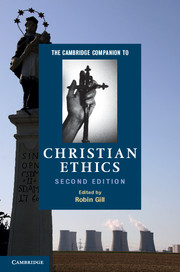Book contents
- Frontmatter
- Part I The grounds of Christian ethics
- Part II Approaches to Christian ethics
- Part III Issues in Christian ethics
- 13 Christianity and war
- 14 The arms trade and Christian ethics
- 15 Social justice and welfare
- 16 Ecology and Christian ethics
- 17 Business, economics and Christian ethics
- 18 World family trends
- 19 Sexuality and religious ethics
- 20 Christian ethics, medicine and genetics
- Select bibliography
- Index
16 - Ecology and Christian ethics
from Part III - Issues in Christian ethics
Published online by Cambridge University Press: 28 January 2012
- Frontmatter
- Part I The grounds of Christian ethics
- Part II Approaches to Christian ethics
- Part III Issues in Christian ethics
- 13 Christianity and war
- 14 The arms trade and Christian ethics
- 15 Social justice and welfare
- 16 Ecology and Christian ethics
- 17 Business, economics and Christian ethics
- 18 World family trends
- 19 Sexuality and religious ethics
- 20 Christian ethics, medicine and genetics
- Select bibliography
- Index
Summary
The existence of an ecological crisis is increasingly recognised as one of the defining features of life in the late modern era. The precise parameters of the crisis are described in different ways, but most accounts include the following features:
(1) Modern humans are witnessing the first major extinction of species originated by human action and the first such mass extinction to occur in a time frame of decades rather than millennia. Scientists estimate the number of lost species as a consequence of human activity at around 10,000 per annum. Biodiversity is reduced by deforestation in both tropical and boreal regions, by the conversion of forests, savannah and wetlands into land for agricultural monocrops or domestic animal grazing; by industrialised deep-sea fishing; by the destruction of coral reefs; and by the increased use of pesticides and herbicides in modern agricultural systems.
(2) The earth is said to be undergoing radical changes in its climatic patterns caused by human activities, and in particular the burning of fossil fuels whose principal uses include space heating, transportation and electricity production. Growth in rice-paddy cultivation and beef-cattle ranching, major sources of methane, also contribute to the enhancement of the greenhouse effect. Evidence for global warming is said to include rising sea levels; rising global air temperatures; accelerating loss of ice in the Arctic Ocean, in Antarctica and Greenland, and on land-based glaciers most notably in the Alps, the Andes and the Himalayas; the increasing number and ferocity of tropical storms; disturbances in the pattern of tropical monsoon rains; and related changes in ocean currents, which enhance the warming and cooling cycle of the Pacific El Niño effect.
(3)...
- Type
- Chapter
- Information
- The Cambridge Companion to Christian Ethics , pp. 219 - 238Publisher: Cambridge University PressPrint publication year: 2011
- 1
- Cited by

